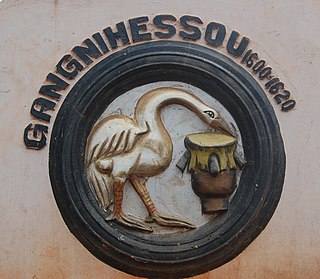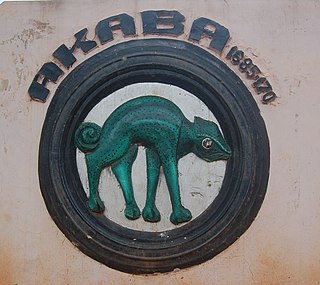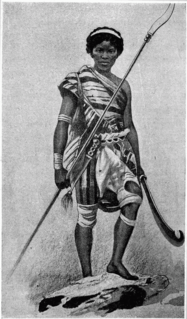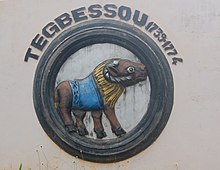
The Kingdom of Dahomey was a West African kingdom located within present-day Benin that existed from approximately 1600 until 1904. Dahomey developed on the Abomey Plateau amongst the Fon people in the early 17th century and became a regional power in the 18th century by conquering key cities on the Atlantic coast.

Do-Aklin or Gangnihessou or Dogbari is claimed as the founder of the Fon Kingdom of Dahomey in present-day Benin and the first person in the royal lineage of the Kings of Dahomey. In many versions he is considered the first king of Dahomey even though the kingdom was founded after his death. Very little is known about Do-Aklin and most of it is connected to folklore, but it is generally claimed that he settled a large group of Aja people from Allada on the Abomey plateau amongst the local inhabitants in c. 1620. His son Dakodonu would eventually build a palace on the plateau and began forming the Kingdom of Dahomey.

Dakodonou ,Dakodonu,Dako Donu or Dako Danzo was an early king of the Kingdom of Dahomey, in present-day Benin, ruling from around 1620 until 1645. Oral tradition recounts that Dakodonu was the son of Do-Aklin, the founder of the royal dynasty of Dahomey, and the father to Houegbadja, often considered the founder of the Kingdom of Dahomey. In addition, it is said that Dakodonu killed a local chieftain and founded the capital city upon the site. However, some recent historical analysis contends that Dakodonu was added into the royal line in the 18th century to legitimize the ruling dynasty over the indigenous inhabitants of the Abomey plateau.

Houegbadja or Wegbaja or Aho was a King in the Kingdom of Dahomey, in present-day Benin, from around 1645 until 1685. Houegbadja followed his father Dakodonu to the throne and formed much of the administration and religious practices for the Kingdom of Dahomey. Because of this he is often credited as the First King of Dahomey.

Akaba was an early King of the Kingdom of Dahomey, in present-day Benin, from 1685 until c.1716. King Houegbadja had created the basic structure of the kingdom on the Abomey plateau. His first children were the twins of Akaba and Hangbe and they were followed by another son of Houegbadja who would become King Agaja. As the oldest son, Akaba became the king upon Houegbadja's death and ruled until 1716 when he died during battle in the Ouémé River Valley, either of small pox or in battle. When he died his sister, Hangbe, became the ruler and began preparing Akaba's oldest son, Agbo Sassa, for the throne. In 1718, Agaja, the next oldest son after Akaba from Houegbadja, fought with Agbo Sassa and Hangbe and became the next King of Dahomey.

Agaja was a king of the Kingdom of Dahomey, in present-day Benin, who ruled from 1718 until 1740. He came to the throne after his brother King Akaba. During his reign, Dahomey expanded significantly and took control of key trade routes for the Atlantic slave trade by conquering Allada (1724) and Whydah (1727). Wars with the powerful Oyo Empire to the east of Dahomey resulted in Agaja accepting tributary status to that empire and providing yearly gifts. After this, Agaja attempted to control the new territory of the kingdom of Dahomey through militarily suppressing revolts and creating administrative and ceremonial systems. Agaja died in 1740 after another war with the Oyo Empire and his son Tegbessou became the new king. Agaja is credited with creating many of the key government structures of Dahomey, including the Yovogan and the Mehu.
Kpengla was a King of the Kingdom of Dahomey, in present-day Benin, from 1774 until 1789. Kpengla followed his father Tegbessou to the throne and much of his administration was defined by the increasing Atlantic slave trade and regional rivalry over the profits from this trade. His attempts to control the slave trade generally failed, and when he died of smallpox in 1789, his son Agonglo came to the throne and ended many of his policies.
Agonglo was a King of the Kingdom of Dahomey, in present-day Benin, from 1789 until 1797. Agonglo took over from his father King Kpengla in 1789 and inherited many of the economic problems that developed during Kpengla's reign. Because of the poor economy, Agonglo was often constrained by domestic opposition. As a response, he reformed many of the economic policies and did military expeditions to try to increase the supply for the Atlantic slave trade. Many of these efforts were unsuccessful and European traders became less active in the ports of the kingdom. As a final effort, Agonglo accepted two Portuguese Catholic missionaries which resulted in a large outcry in royal circles and resulted in his assassination on May 1, 1797. Adandozan, his second oldest son, was named the new king.
Adandozan was a king of the Kingdom of Dahomey, in present-day Benin, from 1797 until 1818. His rule ended with a coup by his brother Ghezo who then erased Adandozan from the official history resulting in high uncertainty about many aspects of his life. Adandozan took over from his father Agonglo in 1797 but was quite young at the time and so there was a regent in charge of the kingdom until 1804. Dealing with the economic depression that had defined the administrations of his father Agonglo and grandfather Kpengla, Adandozan tried to abolish slavery to decrease European trade, and when these failed reform the economy to focus on agriculture. Unfortunately, these efforts did not end domestic dissent and in 1818 at the Annual Customs of Dahomey, Ghezo and Francisco Félix de Sousa, a powerful Brazilian slave trader, organized a coup d'état and replaced Adandozan. He was left alive and lived until the 1860s hidden in the palaces while he was largely erased from official royal history.

Ghezo or Gezo was King of Dahomey from 1818 until 1858. Ghezo replaced his brother Adandozan as king through a coup with the assistance of the Brazilian slave trader Francisco Félix de Sousa. He ruled over the kingdom during a tumultuous period, punctuated by the British blockade of the ports of Dahomey in order to stop the Atlantic slave trade. Ghezo finally ended Dahomey's tributary status to the Oyo empire but also dealt with significant domestic dissent and pressure from the British to end the slave trade. He promised to end the slave trade in 1852, but resumed slave efforts in 1857 and 1858. Ghezo died in 1858, possibly assassinated, and his son Glele became the new king.

The Annual Customs of Dahomey were the main yearly celebration in the Kingdom of Dahomey, held at the capital, Abomey. These ceremonies were largely started under King Agaja around 1730 and involved significant collection and distribution of gifts and tribute, religious ceremonies involving human sacrifice, military parades, and discussions by dignitaries about the future for the kingdom.

The Fon people, also called Fon nu, Agadja or Dahomey, are a Gbe ethnic group. They are the largest ethnic group in Benin found particularly in its south region; they are also found in southwest Nigeria and Togo. Their total population is estimated to be about 3,500,000 people, and they speak the Fon language, a member of the Gbe languages.

The Dahomey Amazons were a Fon all-female military regiment of the Kingdom of Dahomey which existed until 1904. They were so named by Western observers and historians due to their similarity to the mythical Amazons of ancient Anatolia and the Black Sea. This unusual emergence of an all-female military regiment was the result of Dahomey's male population facing high casualties in frequent warfare with neighboring West African states, as well as Dahomey being forced to annually give male slaves to the Oyo Empire. The lack of men likely led the kings of Dahomey to recruit women into the army.

The King of Dahomey was the ruler of Dahomey, an African kingdom in the southern part of present-day Benin, which lasted from 1600 until 1900 when the French Third Republic abolished the political authority of the Kingdom. The rulers served a prominent position in Fon ancestor worship leading the Annual Customs and this important position caused the French to bring back the exiled king of Dahomey for ceremonial purposes in 1910. Since 2000, there have been rival claimants as king and there has so far been no political solution. The Palace and seat of government were in the town of Abomey. Early historiography of the King of Dahomey presented them as absolute rulers who formally owned all property and people of the kingdom. However, recent histories have emphasized that there was significant political contestation limiting the power of the king and that there was a female ruler of Dahomey, Hangbe, who was largely written out of early histories.

Ouidah or Whydah, formerly the chief port of the Kingdom of Whydah, is a city on the coast of the Republic of Benin. The commune covers an area of 364 km2 (141 sq mi) and as of 2002 had a population of 76,555 people.
The Kingdom of Whydah was a kingdom on the coast of West Africa in what is now Benin. It was a major slave trading area which exported more than one million Africans to the United States and Brazil before closing its trade in the 1860s. In 1700, it had a coastline of around 16 kilometres (10 mi); under King Haffon, this was expanded to 64 km (40 mi), and stretching 40 km (25 mi) inland.
The History of the Kingdom of Dahomey spans 400 years from around 1600 until 1904 with the rise of the Kingdom of Dahomey as a major power on the Atlantic coast of modern-day Benin until French conquest. The kingdom became a major regional power in the 1720s when it conquered the coastal kingdoms of Allada and Whydah. With control over these key coastal cities, Dahomey became a major center in the Atlantic Slave Trade until 1852 when the British imposed a naval blockade to stop the trade. War with the French began in 1892 and the French took over the Kingdom of Dahomey in 1894. The throne was vacated by the French in 1900, but the royal families and key administrative positions of the administration continued to have a large impact in the politics of the French administration and the post-independence Republic of Dahomey, renamed Benin in 1975. Historiography of the kingdom has had a significant impact on work far beyond African history and the history of the kingdom forms the backdrop for a number of novels and plays.
Hangbe was the Ruler of the Kingdom of Dahomey, in present-day Benin, for a brief period before Agaja came to power in 1718. Little is known about her because her rule was largely erased from the official Dahomey history and much that is known is brought together by various different oral histories. However, it is often considered that she became the ruler of Dahomey upon the sudden death of King Akaba because his oldest son, Agbo Sassa, was not yet of age. The duration and extent of this rule is not generally agreed upon. She supported Agbo Sassa in a succession struggle between him and Agaja in 1718. Agaja became King of Dahomey and, because of her support for his opponent, her legacy was largely erased from official history.
Hwanjile was a high priest and kpojito of the African Kingdom of Dahomey, in what is now Benin.
The Kingdom of Ardra, also known as the Kingdom of Allada, was a coastal West African kingdom in what is now southern Benin. It was named for its capital, the modern Allada, which was also the main city and major port of the realm.












